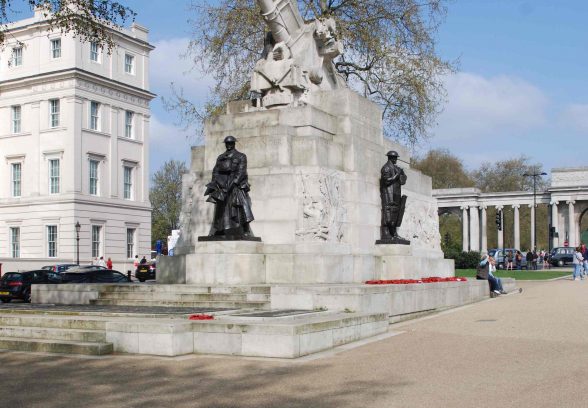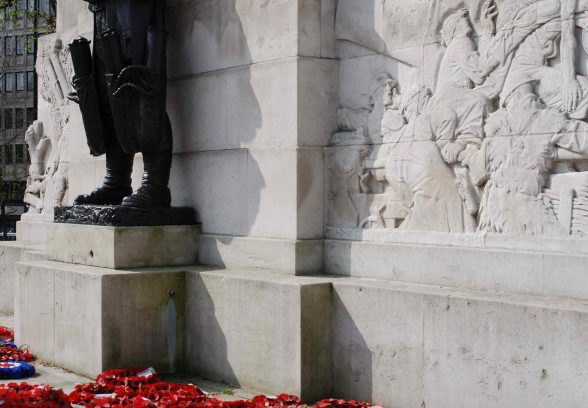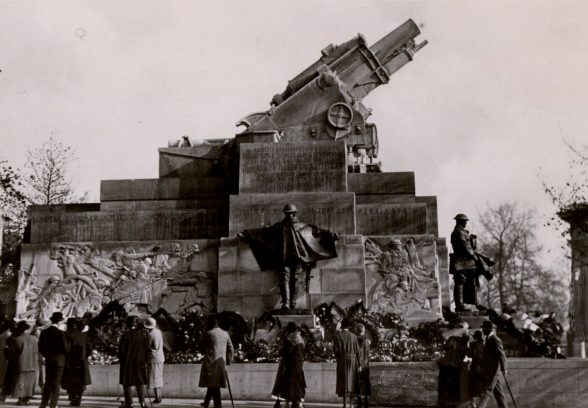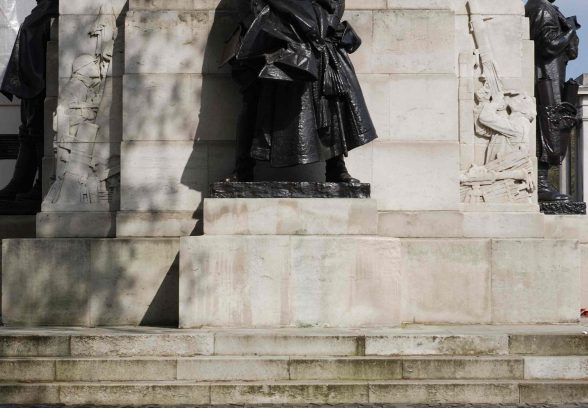This website uses cookies
This website uses cookies to enable it to function properly and to analyse how the website is used. Please click 'Close' to accept and continue using the website.






London: Royal Artillery Memorial
Status: Listed Grade II*
Architect: Lionel Pearson, Charles Sergeant Jagger (Sculpture)
Location: Hyde Park Corner, London
The Royal Artillery Memorial is second only to the Cenotaph as a war memorial as a supreme work of art and is the masterpiece of Charles Sergeant Jagger, surely the greatest British sculptor of his generation and, indeed, of the 20th century. Here, at Hyde Park Corner, Jagger was working with the architect Lionel Pearson of the firm of Adams, Holden & Pearson. Between them, they succeeded in carrying off the dubious experiment of making machinery – military ordnance – into sculpture (fulfilling the wishes of the regiment that the monument should be clearly identifiable as its own), for Pearson’s massive, rectilinear base carries a full- size 9.2 inch howitzer carved in stone. The effect is realistic and yet powerfully architectural.
The Royal Artillery War Commemoration Fund Committee was formed in 1918 and a suitable site for its proposed memorial was found in 1920 at Hyde Park Corner. Adrian Jones, the sculptor of the quadriga on the nearby so-called Wellington Arch, offered his services and various architects and sculptors were approached. These included Herbert Baker and Edwin Lutyens. Working with the sculptor Derwent Wood, Lutyens struggled to produce a design with the “realistic thing” – a gun – requested by the Committee. In the event, no design was found satisfactory and the Committee began to look elsewhere.
In 1921 Jagger, as a “rising and vigorous artist”, was approached, possibly at the suggestion of the painter John Singer Sargent, and he was asked to choose an architect to work with. A model was prepared by the Jagger and Pearson which met with the approval of the Committee and a contract was agreed the following year. The first design had the howitzer placed laterally across a massive symmetrical base, but Jagger soon decided to have the gun aligned with the long axis of the memorial, facing north, with the base now asymmetrical. At the suggestion of the Royal Fine Arts Commission, the orientation was subsequently reversed to create a better composition in relation to the falling ground. A howitzer had been chosen as it was the only gun which Jagger thought suitable to treat as sculpture; as an infantryman, he had respected the Artillery for their “terrific power” and for being the “last word in force” and he wanted to convey these qualities in stone. Below the stone howitzer, life-size bronze statues of an officer, a driver, a shell-carrier, and—a bold decision—a dead soldier are combined with stone reliefs depicting war as painful labour in a style reflecting Jagger’s admiration for Assyrian art.
This was a vision far removed from the symbolic or idealized approach of most contemporary war memorials and the work caused considerable controversy, partly because the howitzer was in stone rather than the more natural-seeming bronze (Jagger said that he did not want a dark object against the skyline). In The Buildings of England, Sir Nikolaus Pevsner refers to the ‘ill-advised portrait in stone of a big gun’, but to Arthur Byron (London Statues, 1981), the Royal Artillery Memorial is ‘a superb work’. In 1949 three bronze panels were added in memory of the 30,000 men of the Royal Artillery who were killed in World War II. A number of side panels, sadly now much worn by the elements, depict the trench mortar, Lewis gun, and the ordinary rifle. Also featured are a French shrine, and a kitchen showing cooking utensils; another shows the sign “wind dangerous” and the bell, which was used as a gong to give warning of the approach of gas. Another panel is devoted to the signallers at work. The names of trench tracks are recorded and another panel records the Royal Arms and the arms of the regiment. It was reported at the time that Jagger wanted the memorial to serve as a record for future generations of the uniform and the equipment used in the Great War. That he has certainly achieved.
Jagger was awarded a gold medal by the Royal Society of British Sculptors “for the best work of the year by a British sculptor in any way exhibited to the public in London.”
There is no idealisation here, no sentimentality; just truthful, brilliantly modelled realism about the brutal nature of conflict, though part of Jagger’s genius was his ability to monumentalise the prosaic.
This great work of art makes a telling, if ludicrous contrast with the symbolism of the nearby Machine Gunners Memorial, which consists of a naked, epicene youth in bronze by Derwent Wood standing on a feeble Classical pedestal bearing the Biblical text “Saul has slain his thousands, but David his tens of thousands.” – which, in view of what machine guns did to human flesh, might seem almost obscene in context. But Jagger had been in the trenches and knew what war was like. His fourth bronze figure on his memorial was of a dead artilleryman, lying anonymously under a tarpaulin at the back, or north end, of the monument. This feature, introduced late in the process, met with opposition, but it meant much to Jagger, who believed that a memorial should tell the public about the horror and terror of war, and he paid for this part of the work himself. Inevitably, perhaps, the Artillery Memorial was at first controversial. The overall design was modern in spirit and resolutely unsentimental. Jagger had declined to embody any symbolism of peace and declined to idealise war, whose real violent nature he wished to convey. An older generation found it difficult to accept that so brutal a thing as a gun could be treated artistically. Lord Curzon pronounced before he died in 1925 that the Artillery Memorial resembled “a toad squatting, which is about to spit fire out of its mouth… nothing more hideous could ever be conceived”. But the former Foreign Secretary and Viceroy of India was out of touch and the public response was generally favourable.
Gavin Stamp
Either enter the name of a place or memorial or choose from the drop down list. The list groups memorials in London and then by country

Become a C20 member today and help save our modern design heritage.